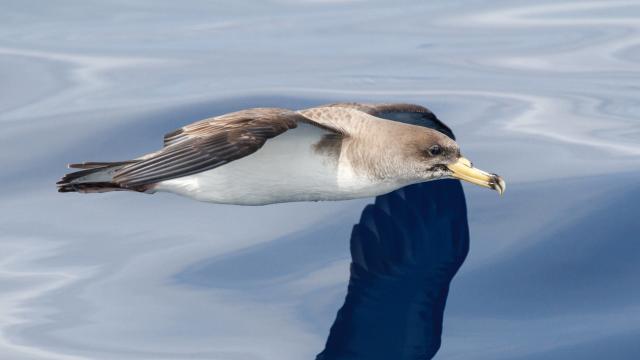In the future, cyborg birds may help monitor ocean currents and help ground-truth satellite data. It may sound like an odd prognostication, but a study released on Thursday in Scientific Reports lays the groundwork.
Scientists slapped small GPS units on Scopoli’s shearwaters, a common seabird found throughout the Mediterranean and east Atlantic. Rather than tracking their flights, they tracked where they went when they settled on the sea surface in the Balearic Sea that sits off Spain’s east coast. The data they collected lined up well with satellite and buoy measurements of wind and ocean current-driven motion, meaning seabirds with GPS could be an unexpectedly functional new part of our Earth-monitoring network.
The bird GPS breakthrough arose thanks to collaboration between ocean-studying physicists and biologists at Mediterranean Institute for Advanced Studies, known by its Spanish acronym IMEDEA. The biologists were familiar with Scopoli’s shearwaters, a gull-sized seabird, and its habits as it moved between the Balearic Islands and the Iberian peninsula to forage while raising chicks. To track those movements and understand the birds’ life cycle, they attached GPS units to them.
The ocean folks, meanwhile, are always hunting for more ways to get data since buoys and ship measurements can be sparse and satellites—while providing a great big picture view—need on-the-ground measurements to ensure they’re functioning properly. The GPS work going on with the birds provided a unique opportunity to capture some very intimate on-the-ground data.
“So we decided to take advantage of the data collected by biologists,” Antonio Sánchez Roman, the IMEDEA physicist who led the study, told Earther.
All told, Sánchez Roman and his co-authors were able to analyse 405 birds. They found the birds spent six-hour periods sitting in the water on average, though occasionally that could stretch up to 10 hours. They then compared the birds’ tracks to satellite measurements and other data and found that the birds were surprisingly good at measuring the motion in the ocean. About three-quarters of the birds were guided on their path by wind, waves, and currents, while 59 per cent were directly pushed around by sea surface currents.
The birds themselves did very little active swimming. Rather they were doing what the study calls “rafting,” which is exactly what it sounds like.
“This type of data can be considered as a complementary source of data for the traditional measurements and analysis,” Sánchez Roman said. “Moreover, this type of data could help to fill gaps and obtain information about surface currents and winds in poor sampled areas.”
There’s no immediate plan to turn the world’s seabirds into an internet of things-like network of ocean sensors. But the approach does provide a proof-of-concept for how scientists could gather data and improve our understanding of remote high seas. It’s easy to imagine this technique being used in the thawing Arctic or offshore of developing countries to monitor ocean currents, potential toxic tides, conservation areas, or even to aid fishermen.
This isn’t the first time we’ve strapped sensors to animals to better understand our environment. Seals and whales have both been outfitted with sensors to provide ocean data. It all sounds a little Black Mirror to be sure, but the potential to use the data from these cyborg-esque animals (and trees!) to meet conservation goals could ensure that we don’t end up with a world of electric sheep.
